Scottish Marine and Freshwater Science Volume 5 Number 16:The Avoidance Rates of Collision Between Birds and Offshore Turbines
This study reviewed data that have been collected from offshore windfarms and considers how they can be used to derive appropriate avoidance rates for use in the offshore environment.
6. Sensitivity Analysis
Within windfarm avoidance rates can be derived from sites at which estimates of collision rates and bird activity are available using the parameters listed in Table 6.1 and following equation 6 (see section 3.1). However, many of these parameters are incorporated into the calculations as mean values, or a range of values, and others must be estimated. Therefore, in order to understand how transferable these values may be between different models and situations, it is important to understand how sensitive the final avoidance rates are to each of the model input parameters. If avoidance rates are found to be highly sensitive to variation in one or more of the input parameters, it may raise questions about whether or not it is appropriate to apply the avoidance rates derived to novel sites.
For this reason, we assess the sensitivity of each of the avoidance rates presented in Appendix 7 to different input parameters. These parameters include corpse correction factors used to correct for the efficacy of corpse searches (observed collision rate in eq. 6), which will be influenced by scavenger behaviour and searcher efficiency, and estimates of the number of birds passing through a windfarm over a given period of time (flux rate in eq. 6). They also include parameters used to calculate collisions in the absence of avoidance behaviour (P coll in eq. 6) including bird behavioural parameters such as flight speed and altitude, and turbine parameters such as rotor speed and pitch.
Avoidance may also be sensitive to a range of additional factors which cannot be easily quantified. These include time of day, weather, proximity to breeding colonies or overlap with migration routes and the size of the turbines concerned. We use a brief literature review to consider how each of these factors may influence the avoidance rates we derive.
6.1 Avoidance rates derived using the basic Band model (options 1 and 2)
The variables used to estimate P coll, the first step to deriving an avoidance rate, are subject to differing levels of uncertainty. Some, such as rotor diameter, blade width and turbine height are fixed and are, therefore, known quantities with very little, if any, uncertainty surrounding them. Others, such as rotor speed and pitch and aspects of bird behaviour, such as flight speed and altitude and the propensity to fly upwind or downwind are subject to a greater degree of uncertainty. As part of the sensitivity analysis, we focus on the parameters which are not fixed and, therefore, subject to varying degrees of uncertainty, in order to determine what influence the inaccurate estimation of each of these parameters has on the final derived avoidance rates. Whilst the focus of much of the interest in collision risk modelling has been on avoidance rates, it is actually 1-avoidance rate, or the non-avoidance rate which is applied in the final step of the Band collision risk model (Band pers. comm., Masden et al. in prep). For this reason, we focus our sensitivity analysis on this factor, rather than the avoidance rate.
For each of the sites and species combinations presented in Appendix 7 at which collisions were recorded, we consider the impact that a 10% increase (following Chamberlain et al. 2006) in each of rotor speed, rotor pitch, bird flight speed, flux rate and the proportion of flights upwind would have on the avoidance rates derived using option 1. In addition, we also consider the influence of a 10% increase in corpse detection rate.
Table 6.1 Input parameters for the Band (basic and extended model)
| Parameter |
Sensitivity assessed |
|---|---|
| Species name |
No |
| Bird length |
No |
| Wingspan |
No |
| Flight speed |
Yes - 10% increase considered following Chamberlain et al. (2006) |
| Nocturnal activity factor (1-5) |
Considered as part of increase in flux rate |
| Flight type, flapping or gliding |
No - Seabirds most likely to engage in flapping flight, which is the higher risk activity |
| Daytime bird density |
Yes - considered as part of increase in flux rate |
| Proportion at rotor height |
Yes - 10% increase in birds flying at risk height considered for basic model, 200 randomly simulated distributions considered for the extended model |
| Proportion of flights upwind |
Yes - 10% increase in the proportion of birds flying upwind considered |
| Name of windfarm site |
No - Fixed parameter |
| Latitude |
No - Fixed parameter |
| Number of turbines |
No - Fixed parameter |
| Width of windfarm |
No - Fixed parameter |
| Tidal offset |
No - Suitable datasets were only available for onshore windfarms |
| Turbine model |
No - Fixed parameter |
| No. of blades |
No - Fixed parameter |
| Mean rotation speed |
Yes - 10% increase considered following Chamberlain et al. (2006) |
| Rotor radius |
No - Fixed parameter |
| Hub height |
No - Fixed parameter |
| Monthly proportion of time operational |
Yes - considered as part of increase in flux rate |
| Max blade width |
No - Fixed parameter |
| Pitch |
Yes - 10% increase considered following Chamberlain et al. (2006) |
6.1.1 Sensitivity to the assumed flux rate at the windfarm
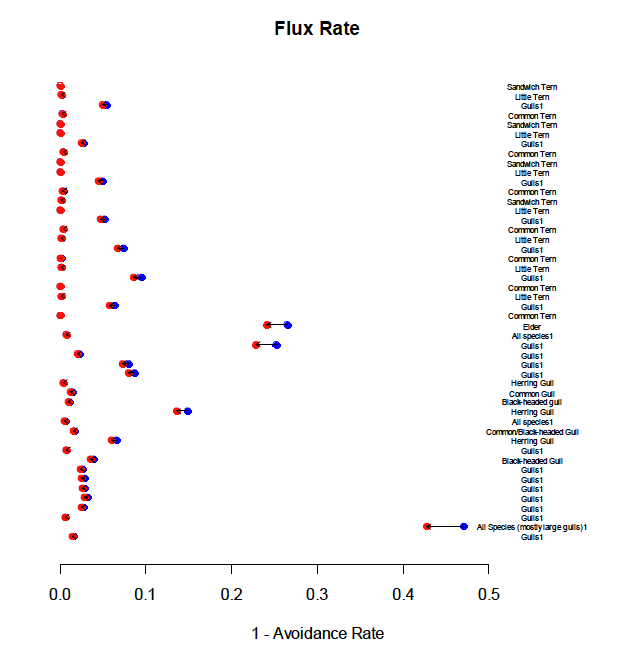
Figure 6.1 Sensitivity of non-avoidance rates for each species and site in Appendix 7 at which a collision was recorded and derived using the basic Band model, to the assumed flux rate at each site. Blue dots indicate the non-avoidance rate derived assuming the flux rate presented in Appendix 7, red dots indicate the non-avoidance rate derived assuming a 10% increase in the flux rate at each site.
Bird flux rate is an estimate of the total number of birds passing through the windfarm when it is operational. As such, it combines estimates of the number of birds recorded within the windfarm, the proportion of birds at collision risk height, corrections for nocturnal activity and an estimate of the monthly proportion of time it is operational. An increase in the flux rate derived at each site results in a decrease in the derived non-avoidance rates ( Figure 6.1). This is because, whilst the observed number of collisions remains constant, the number of birds passing through the windfarm increases, meaning that a greater proportion of them are assumed to have avoided collision. These changes are approximately inversely proportional to the increase in the numbers of birds passing through the site. A comparison of the mean non-avoidance rates based on the flux rate presented in Appendix 7, with the mean non-avoidance rates assuming a 10% increase in this flux rate suggests that such an increase may result in a 9.1% decrease in the non-avoidance rate.
6.1.2 Sensitivity to the corpse detection rate at the windfarm
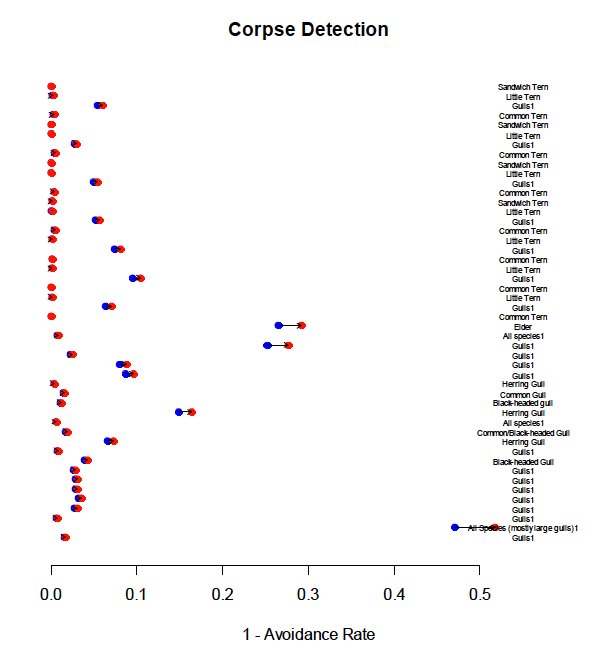
Figure 6.2 Sensitivity of non-avoidance rates for each species and site in Appendix 7 at which a collision was recorded and derived using the basic Band model, to the assumed corpse detection rate at each site. Blue dots indicate the non-avoidance rate derived assuming the number of collisions presented in Appendix 7, red dots indicate the non-avoidance rate derived assuming a 10% increase in the number of collisions detected at each site.
During the search for collision victims, corpses may be missed either as a result of searcher inefficiency, or through the removal of carcasses by predators (Winkelman 1992). As a result it is often necessary to correct observed collision rates to account for these missing corpses. Assuming an increase in the total number of victims leads to an increase in the derived non-avoidance rate because the total number of birds passing through the windfarm remains constant and it is assumed a higher proportion of them collide with the turbines. These increases in the non-avoidance rate are proportional with the increase in corpse detection ( Figure 6.2), with a 10% correction in the number of collisions to account for a failure to detect corpses resulting in 10% increase in the non-avoidance rate.
6.1.3 Sensitivity to the proportion of birds flying upwind
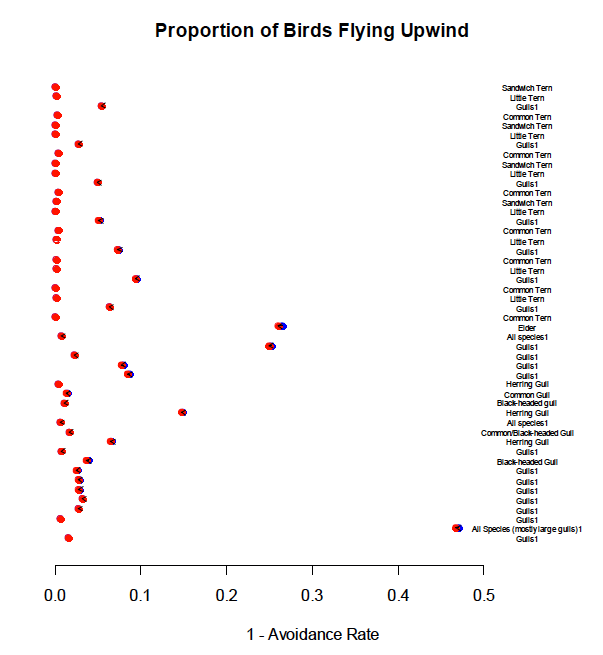
Figure 6.3 Sensitivity of non-avoidance rates for each species and site in Appendix 7 at which a collision was recorded and derived using the basic Band model, to the proportion of birds flying upwind at each site. Blue dots indicate the non-avoidance rate derived assuming the number of collisions presented in Appendix 7, red dots indicate the non-avoidance rate derived assuming a 10% increase in the proportion of birds flying upwind detected at each site.
A 10% change to the proportion of birds flying upwind resulted in a small decrease in the derived non-avoidance rates ( Figure 6.3) of 1.17%. These results suggest that the proportion of birds estimated to fly up or downwind has a relatively small effect on the final, derived non-avoidance rate.
6.1.4 Sensitivity to the mean turbine rotor speed
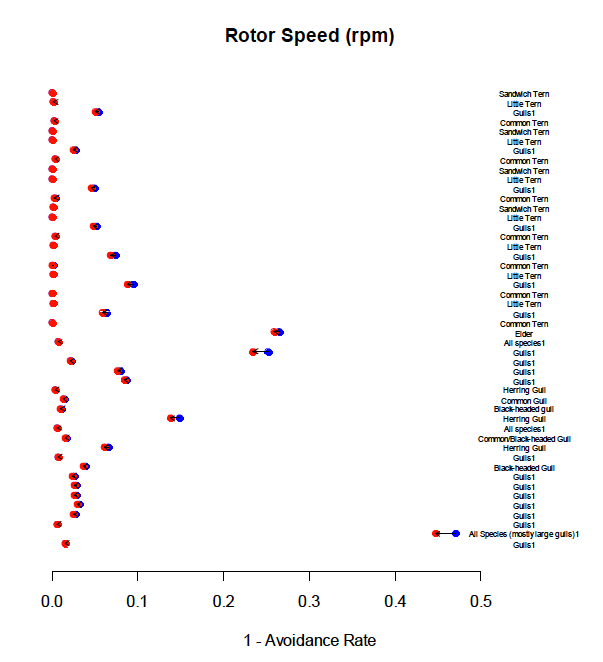
Figure 6.4 Sensitivity of non-avoidance rates for each species and site in Appendix 7 at which a collision was recorded and derived using the basic Band model, to the turbine rotor speed at each site. Blue dots indicate the non-avoidance rate derived assuming the number of collisions presented in Appendix 7, red dots indicate the non-avoidance rate derived assuming a 10% increase in the turbine rotor speed at each site.
A 10% increase in the mean turbine rotor speed assumed typically resulted in a decrease in the derived non-avoidance rates of approximately 5.5% ( Figure 6.4). The reason for this decrease is that as the rotor speed increases, the time available for a bird to pass through unharmed decreases, meaning that the predicted collision rate increases whilst the recorded number of collisions remains constant. Based on the turbines we considered, a 10% increase in mean rotor speed reflects an increase of between 1 and 4 rotations per minute. Published data from turbine manufacturers ( http://www.4coffshore.com/) suggests the range of operational speeds for turbines is like to vary by between 5 and 15 rpm. As such, the increase in rotation speed we consider may be somewhat conservative but, without more detailed curves showing the range of operational speeds used by different turbines, assessing this is difficult.
6.1.5 Sensitivity to the turbine pitch
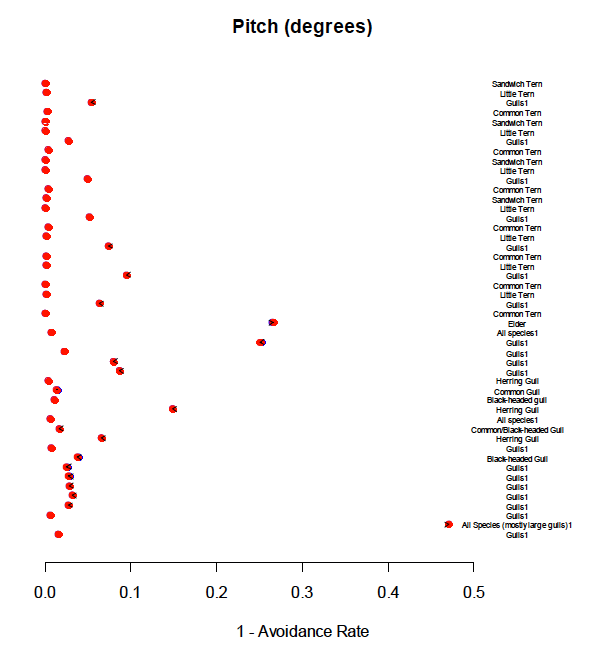
Figure 6.5 Sensitivity of non-avoidance rates for each species and site in Appendix 7 at which a collision was recorded and derived using the basic Band model, to the turbine pitch at each site. Blue dots indicate the non-avoidance rate derived assuming the number of collisions presented in Appendix 7, red dots indicate the non-avoidance rate derived assuming a 10% increase in the turbine pitch at each site.
A 10% change in the assumed turbine pitch resulted in a fairly negligible decrease in the derived non-avoidance rates ( Figure 6.5) of 0.2%. Our calculations were based on an assumption of a 10˚ pitch for each turbine, so a 10% increase reflects an 11˚ pitch. Available data describing the pitch of operational turbines are extremely limited. As a consequence, it is not possible to determine how well these values reflect reality at operational turbines.
6.1.6 Sensitivity to the bird flight speed
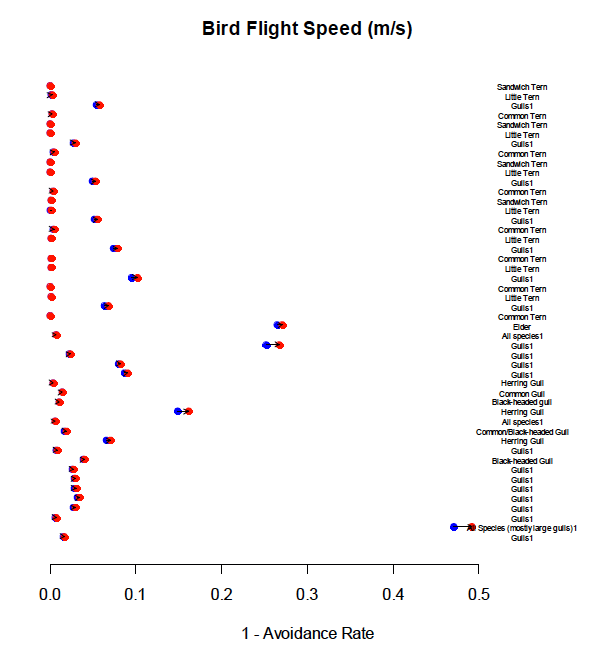
Figure 6.6 Sensitivity of non-avoidance rates for each species and site in Appendix 7 at which a collision was recorded and derived using the basic Band model, to the bird flight speed at each site. Blue dots indicate the non-avoidance rate derived assuming the number of collisions presented in Appendix 7, red dots indicate the avoidance rate derived assuming a 10% increase in the bird flight speed at each site.
A 10% increase in the assumed bird flight speed resulted in an increase in the derived non-avoidance rates ( Figure 6.6) of 5.5%. This increase reflects the fact that the faster a bird passes through the rotor swept-area, the less likely it is to be hit. As a result an increase in flight speed results in a decrease in the predicted number of collisions whilst the observed number of collisions remains constant. For our study species a 10% increase in flight speed reflects an increase of 1-1.3 m/s. Alerstam et al. (2007) suggest that the standard deviations around the mean flight speeds for our study species are in the region of 1-2 m/s, suggesting that a 10% increase in flight speed may be a realistic, precautionary assumption.
6.1.7 Basic Band model sensitivity conclusions
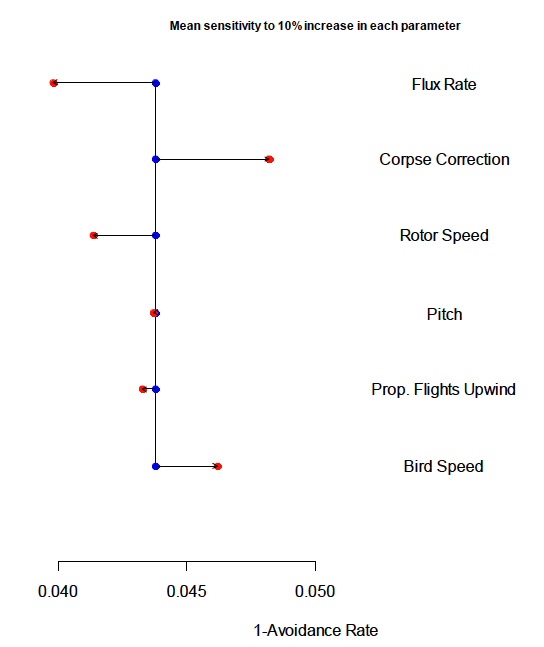
Figure 6.7 Sensitivity of derived non-avoidance rates derived using the basic Band model to a 10% increase in each of the Band model parameters.
Of the parameters considered, the final derived non-avoidance rates were most sensitive to flux rate and the corpse correction ( Figure 6.7). An increase in the flux rate meant that the predicted collision rate increased, whilst the observed collision rate remained constant (see eq. 6, section 3.1); as a consequence, the non-avoidance rate decreased in response to an increase in the flux rate. For similar reasons, an increase in the number of corpses detected resulted in an increase in the non-avoidance rate derived. The impacts of assumed rotor speed and bird speed on the derived non-avoidance rates were of a similar magnitude, but in opposite directions. An increased assumed rotor speed results in a decreased non-avoidance rate because faster turbines result in an increased risk of collision. As a consequence, a faster rotor speed would result in an increase in the predicted collision rate, whilst the observed collision rate remains constant. This results in a decrease in the non-avoidance rate. In contrast, an increase in the assumed speed of the birds passing through the rotor swept area of a turbine decreases the risk of collision. As a consequence, the predicted collision rate decreases and, for the reasons stated above, the non-avoidance rate derived increases. Whilst increases in both the assumed pitch and the proportion of flights upwind resulted in decreases in the derived non-avoidance rates, the impact of both parameters was negligible.
6.2 Avoidance rates derived using the extended Band model (option 3)
In addition to the variables described above ( section 6.1), non-avoidance rates derived using the extended Band model are also likely to be sensitive to the assumed flight height distributions. Collision risk is not evenly distributed within the rotor swept area of turbines, and is greatest towards the centre of the rotor disk. The extended Band model makes use of flight height distributions, such as those derived by Johnston et al. (2014a) to account for this variable risk. However, as these are continuous distributions, it is not appropriate to simply assume, for example, that an additional 10% of birds fly at rotor height as this will have implications for the overall shape of the distribution. Therefore, in addition to the parameters considered for the basic Band model, for each species/site combination we consider, we use 200 random distributions estimated following the methodology of Johnston et al. (2014a) to investigate sensitivity to the assumed distribution ( Figure 6.8). It is important to note that by comparing between different distributions, the outputs of the sensitivity analysis will not be strictly comparable to the outputs of the sensitivity analyses described above.
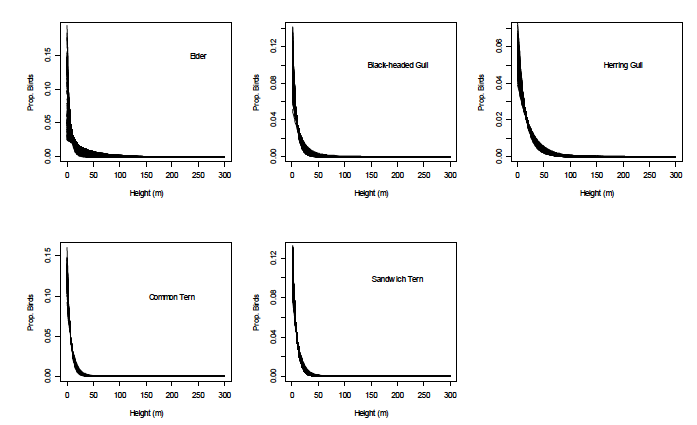
Figure 6.8 200 Random flight height distributions estimated for each of eider, black-headed gull, herring gull, common tern and Sandwich tern, species for which avoidance rates could be derived from a combination of recorded collisions and recorded levels of bird activity, using the methodology set out in Johnston et al. (2014a) and used to assess the sensitivity of derived avoidance rates to the assumed flight height distribution.
6.2.1 Sensitivity to assumed flight height distribution
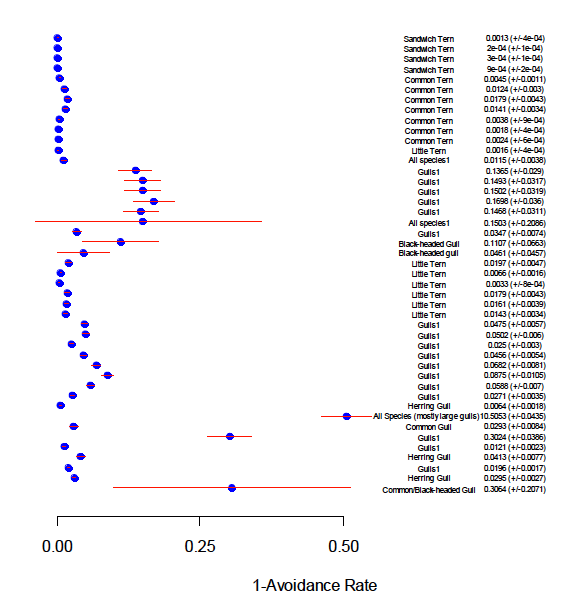
Figure 6.9 Sensitivity of non-avoidance rates derived for each species and site in Appendix 7 at which a collision was recorded and derived using the extended Band model, to the assumed flight height distribution at the site. Blue dots indicate the mean non-avoidance rate values derived from 200 random flight height distributions at each site, red lines indicate the standard deviation around these values, actual values shown alongside plot.
The sensitivity of the derived non-avoidance rates to different flight height distributions appears to be highly variable ( Figure 6.9). The greatest sensitivity appears to occur where derived non-avoidance rates are highest. This relationship is likely to reflect the level of activity at any given site. For example, consider two sites, at the first of which 1 flight out of 100 at rotor height results in a collision and at the second of which 1 flight out of 1000 results in a collision. If the estimate of the proportion of birds flying at rotor height increases at each site by 10%, whilst the recorded number of collisions remains constant, this becomes 1 flight out of 110 at the first site and 1 flight out of 1,100 at the second. At the first site the non-avoidance rate decreases from 0.0100 to 0.0091, whilst at the second it decreases from 0.0010 to 0.0009. The overall decrease is therefore greater at the first site, with the lower level of flight activity.
6.2.2 Sensitivity to the assumed flux rate at the windfarm
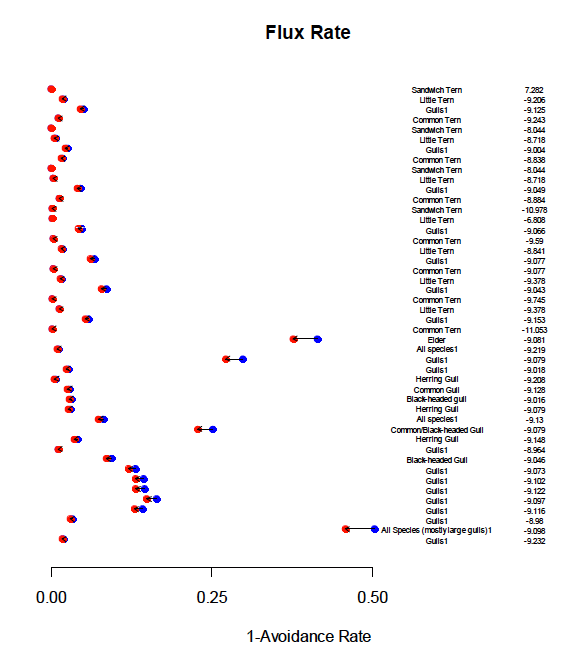
Figure 6.10 Sensitivity of non-avoidance rates derived for each species and site in Appendix 7 at which a collision was recorded and derived using the extended Band model, to the assumed flux rate at each site. Blue dots indicate the non-avoidance rate derived assuming the flux rate presented in Appendix 7, red dots indicate the non-avoidance rate derived assuming a 10% increase in the flux rate at each site. % change in the non-avoidance rates following a 10% increase in flux rate shown alongside graph.
Bird flux rate is an estimate of the total number of bird passing through the windfarm when it is operational. As such, it combines estimates of the number of birds recorded within the windfarm, corrections for nocturnal activity and an estimate of the monthly proportion of time it is operational. An increase in the flux rate derived at each site results in a decrease in the derived non-avoidance rates ( Figure 6.10). This is because, whilst the observed number of collisions remains constant, the number of birds passing through the windfarm increases, meaning that a greater proportion of them are assumed to have avoided collision. These decreases are roughly inversely proportional to the increase in flux rate, although in contrast to the case of the basic Band model, this value will vary across sites as a consequence of the different height distributions assumed. A comparison of the mean avoidance rates based on the flux rate presented in Appendix 7, with the mean avoidance rates assuming a 10% increase in this flux rate suggests that such an increase may result in a mean 8.73% decrease in the non-avoidance rate.
6.2.3 Sensitivity to the corpse detection rate at the windfarm
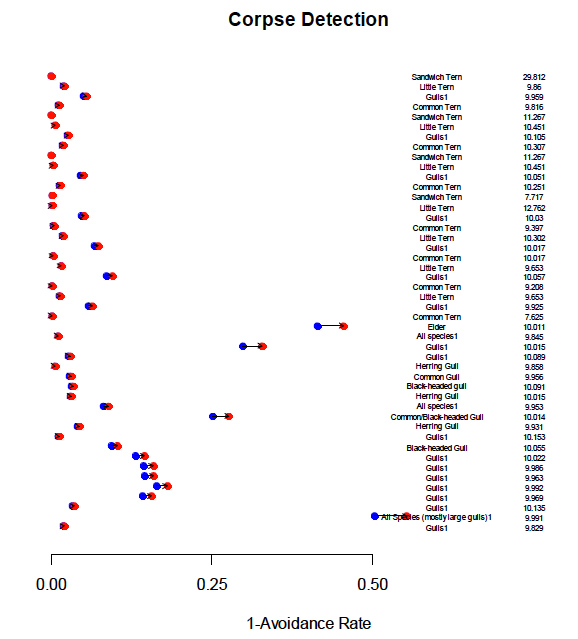
Figure 6.11 Sensitivity of non-avoidance rates for each species and site in Appendix 7 at which a collision was recorded and derived using the extended Band model, to the assumed corpse detection rate at each site. Blue dots indicate the non-avoidance rate derived assuming the number of collisions presented in Appendix 7, red dots indicate the non-avoidance rate derived assuming a 10% increase in the number of collisions detected at each site. % change in the non-avoidance rates following a 10% increase in the number of collisions detected shown alongside graph.
During the search for collision victims, corpses may be missed either as a result of searcher inefficiency, or through the removal of carcasses by predators (Winkelman 1992). As a result it is often necessary to correct observed collision rates to account for these missing corpses. Assuming an increase in the total number of victims leads to an increase in the derived non-avoidance rate because the total number of birds passing through the windfarm remains constant and it is assumed a higher proportion of them collide with the turbines ( Figure 6.11). This increase is broadly proportional with the increase in the flux rate across sites, with a mean 10.43% increase in the non-avoidance rate following a 10% increase in the flux rate.
6.2.4 Sensitivity to the proportion of birds flying upwind
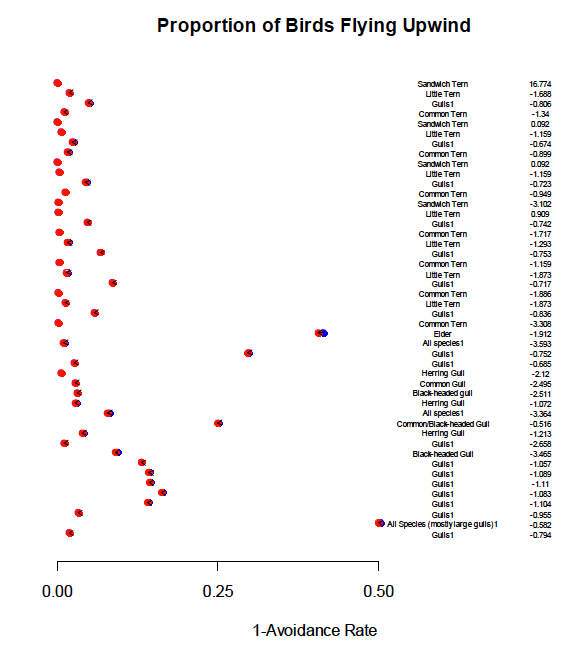
Figure 6.12 Sensitivity of non-avoidance rates derived for each species and site in Appendix 7 at which a collision was recorded and derived using the extended Band model, to the proportion of birds flying upwind at each site. Blue dots indicate the non-avoidance rate derived assuming 50% of birds flying upwind, red dots indicate the avoidance rate derived assuming a 10% increase in the proportion of birds flying upwind at each site. % change in the non-avoidance rates following a 10% increase in the proportion of birds flying upwind shown alongside graph.
A 10% change to the proportion of birds flying upwind resulted in a fairly negligible decrease in the derived avoidance rates ( Figure 6.12). The % increases were typically <1%, and across all sites a 10% increase in the proportion of birds flying upwind resulted in a decrease in the non-avoidance rate of approximately 0.97%. These results suggest that the proportion of birds estimated to fly up or downwind has a negligible effect on the final, derived non-avoidance rate.
6.2.5 Sensitivity to the turbine rotor speed
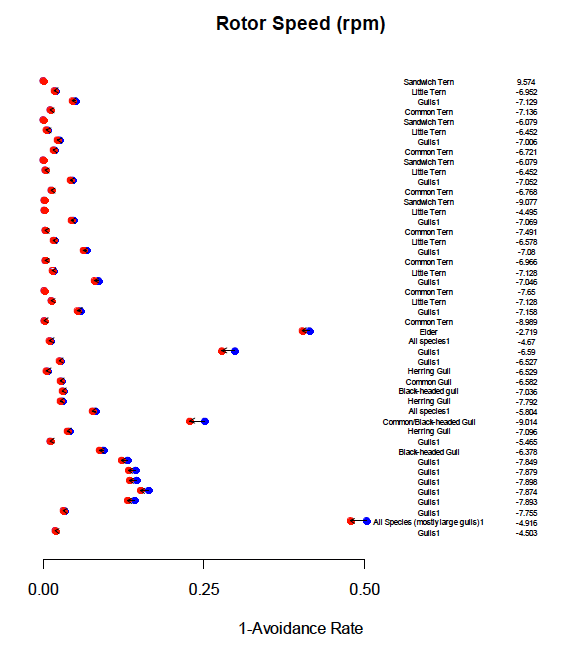
Figure 6.13 Sensitivity of non-avoidance rates derived for each species and site in Appendix 7 at which a collision was recorded and derived using the extended Band model, to the turbine rotor speed. Blue dots indicate the non-avoidance rate derived based on the rotor speed values presented in Appendix 7, red dots indicate the non-avoidance rate derived assuming a 10% increase in these rotor speeds. % change in the non-avoidance rates following a 10% increase in the turbine rotor speed shown alongside graph.
A 10% increase in the assumed turbine rotor speed typically resulted in a decrease in the derived non-avoidance rates ( Figure 6.13). Across all sites a 10% increase in the rotor speed resulted in a decrease in the non-avoidance rate of approximately 6.45%.
6.2.6 Sensitivity to the turbine pitch
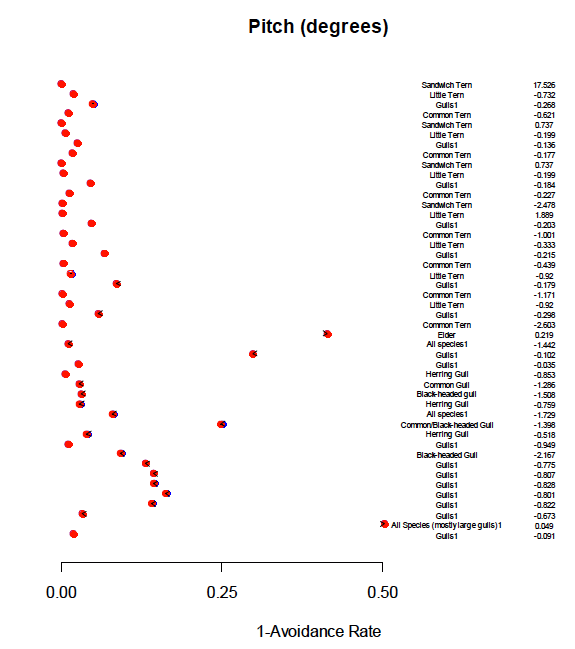
Figure 6.14 Sensitivity of non-avoidance rates derived for each species and site in Appendix 7 at which a collision was recorded and derived using the extended Band model, to the turbine pitch. Blue dots indicate the non-avoidance rate derived based on the rotor speed values presented in Appendix 7, red dots indicate the non-avoidance rate derived assuming a 10% increase in the pitch. % change in the non-avoidance rates following a 10% increase in the turbine rotor speed shown alongside graph.
A 10% change in the assumed turbine pitch resulted in a fairly negligible decrease in the derived non-avoidance rates ( Figure 6.14). The % decreases were typically <1%, and across all sites a 10% increase in the turbine pitch resulted in a decrease in the non-avoidance rate of approximately 0.21%.
6.2.7 Sensitivity to the bird flight speed
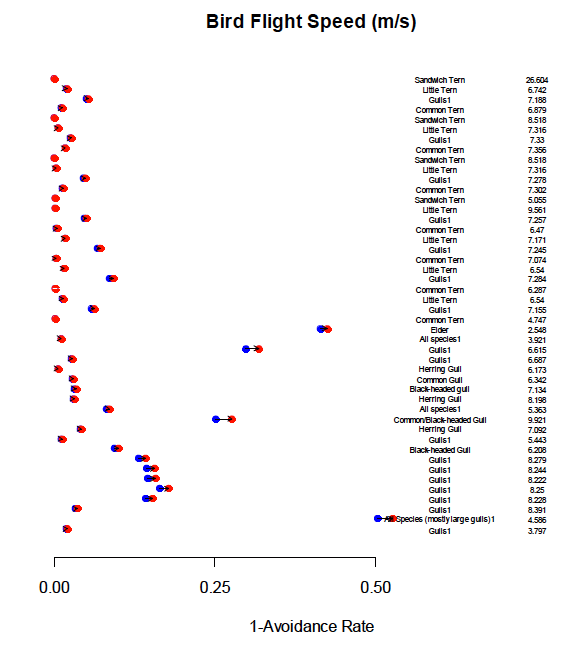
Figure 6.15 Sensitivity of non-avoidance rates derived for each species and site in Appendix 7 at which a collision was recorded and derived using the extended Band model, to the bird flight speed. Blue dots indicate the non-avoidance rate derived based on the bird flight speed values presented in Table 5.4, red dots indicate the non-avoidance rate derived assuming a 10% increase in the bird flight speed. % change in the non-avoidance rates following a 10% increase in the bird flight speed shown alongside graph.
A 10% increase in the assumed bird flight speed typically resulted in an increase in the derived non-avoidance rates ( Figure 6.15). Across all sites a 10% increase in the bird flight speed resulted in an increase in the non-avoidance rate of approximately 7.31%.
6.2.8 Extended Band model sensitivity conclusions
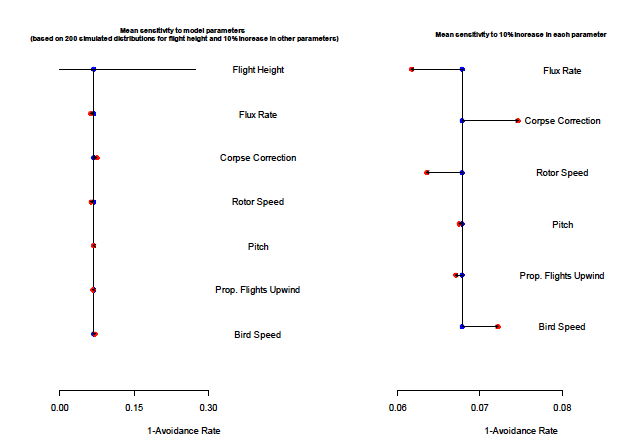
Figure 6.16 Sensitivity of non-avoidance rates derived using the extended Band model to Band model parameters. Sensitivity to flight height distribution is assessed by considering the standard deviation calculated from non-avoidance rates derived using 200 randomly simulated flight height distributions and sensitivity to the remaining parameters is derived from a 10% increase in the values presented in Appendix 7 and Table 5.4.
Of the parameters considered, the derived non-avoidance rates appear to be most sensitive to the assumed flight height distribution ( Figure 6.16). However, the assessment of sensitivity for this parameter is not strictly comparable to that for the other parameters as it is not possible to make a simple assumption about a change in a continuous distribution in the same way it is about a change in, for example, rotor speed or bird numbers. Furthermore, the magnitude of the sensitivity in this parameter may be strongly influenced by 11 of the 45 data points, for which there was particularly high variation around the mean values ( Figure 6.9). On closer examination, this variation appears to be strongly linked to sites with relatively low levels of bird activity ( Figure 6.17).
Of the remaining parameters, the derived non-avoidance rates were most sensitive to changes in the flux rate at the windfarm (the number of birds passing through over the course of the study period) and the accuracy with which corpses were detected. Both rotor speed and bird speed also appeared to have a moderate influence on the derived non-avoidance rates ( Figure 6.18). The sensitivity of the non-avoidance rates to the input parameters appeared to be relatively consistent between option 1 and option 3.
Sensitivity to each parameter also appeared to be strongly linked to the number of birds estimated flying through each monitored windfarm (Figures 6.10 and 6.17). As the number of birds passing through a site increases, the sensitivity of the derived non-avoidance rates to each of the model parameters, including the assumed flight height distribution, drops markedly. This finding is consistent with that of Douglas et al. (2012) who found that the sensitivity of predicted collision rates to input parameters dropped as the quantity of observational data increased. In the case of sensitivity to the assumed flight height distributions used, at sites where flight activity is greatest, the derived avoidance rates have a similar level of variability to this and to other parameters. This is because for two sites where similar numbers of collisions are recorded, but at which the levels of bird activity differ, the non-avoidance rate will be higher at the site with the lowest level of bird activity. As a consequence, where an identical change occurs at both sites, the total change in the non-avoidance rate will be greatest at the site with the lowest level of bird activity.
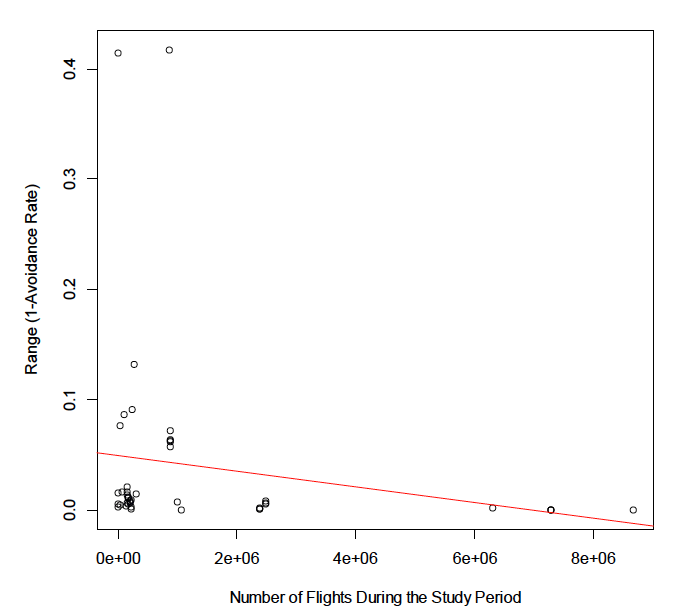
Figure 6.17 Sensitivity of the non-avoidance rate derived using option 3 of the Band model to the assumed flight height distribution.
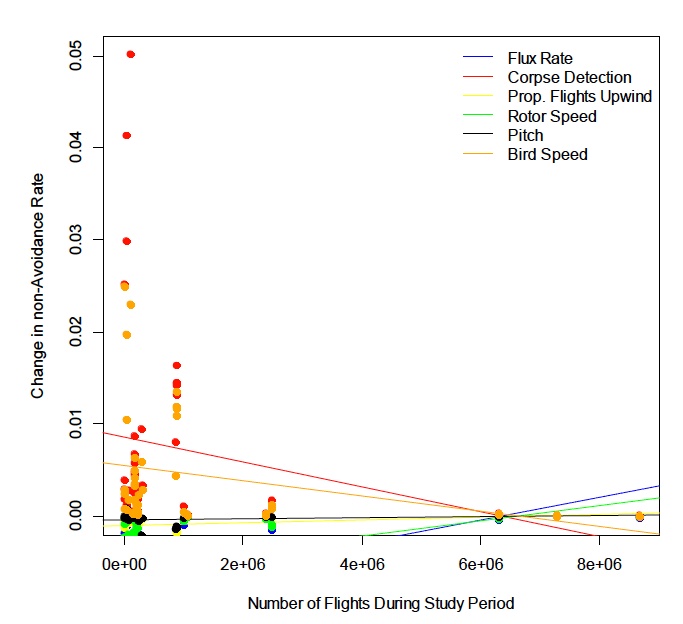
Figure 6.18 Sensitivity of non-avoidance rates derived using option 3 of the Band model to a 10% increase in each of the following parameters - flux rate, corpse detection, proportion of flights upwind, rotor speed, pitch and bird speed.
6.3 Sensitivity analysis conclusions
Avoidance rates derived using both the extended and basic Band models were sensitive to uncertainty surrounding the flux rate, corpse correction factor, rotor speed and bird speed. Whilst we considered a 10% increase in each of these parameter values to test the sensitivity of the models to the underlying assumptions, it would be valuable to consider how this compares to the actual range in each of these parameters experienced at each site. This would enable us to better quantify the uncertainty surrounding the derived avoidance rates. However, such an analysis would be complex, especially given that some parameters may co-vary, or be influenced by factors not included in the model, for example, both rotor speed and bird speed are likely to be influenced by wind speed. Such an analysis would be beyond the scope of this project and has not been considered here.
6.4 Sensitivity to other external factors
6.4.1 Weather
The flight behaviour of birds may be strongly influenced by weather conditions. However, much of the research on this subject has been carried out in relation to migration ( e.g. Larkin & Thompson 1980, Gauthreaux 1991, Zehnder et al. 2001, Dokter et al. 2011). Weather is likely to influence avoidance behaviour in two ways. Firstly, by reducing visibility, making it harder to detect hazards and, therefore, increasing the risk of collision and, secondly, by affecting the manoeuvrability of birds as a result of strong winds or the presence of thermals (Spear & Ainley 1997, Shamoun-Baranes et al. 2006, Shamoun-Baranes & van Loon 2006).
Increases in the numbers of recorded collisions between birds and wind turbines, or other man-made objects, have been widely reported following periods of dull, overcast weather (Crawford 1981, Winkelman 1992, Bevanger 1994). This is likely to be because poor visibility reduces the ability of birds to detect turbines, and may lead to them becoming disorientated (Williams et al. 1974, Able 1982, Richardson 1990). As a result, the avoidance rates of individual birds are likely to be lower during periods of poor visibility. However, data used for collision risk modelling are based on the abundance of birds in flight within the windfarm, during conditions with good visibility (Camphuysen et al. 2004).
In contrast, there is some, limited, evidence that some bird species may be more likely to forage inland, and less likely to fly during periods of poor visibility (Williams et al. 1974, Pinder 1989), reducing the number of birds in flight within the windfarm in comparison to baseline survey data used in collision risk modelling. Such a potential reduction in the number of birds in flight needs to be factored into the avoidance rates used in collision risk modelling.
As a result, it is unclear as to the extent to which conditions with poor visibility may affect the avoidance rates necessary for use in offshore windfarms. To understand the potential importance of this, it is necessary to quantify the proportion of birds likely to be in flight, at sea when visibility is poor. Data collected using modern GPS tags has the potential to answer this problem and also inform on nocturnal flight activity.
Wind speed and direction both influence bird flight behaviour ( e.g. Spear & Ainley 1997, Safi et al. 2013), with potential implications for avoidance rates. At onshore windfarms, birds have been observed to exhibit less risky flight behaviour during periods of increasing wind (Barrios & Rodriguez 2004). During periods of strong winds, Krijgsveld et al. (2011) noted a decrease in the number of birds in flight around Egmond aan Zee. However, as these data were collected using radar, they emphasise that these observations may reflect increased clutter from waves, rather than a decrease in the total number of birds.
Studies have demonstrated that birds make use of wind conditions to minimise the energetic cost of flight and optimise the trade-off between the maximum range they can reach and the energy they expend in reaching it (Williams et al. 1974, Spear & Ainley 1997, de Lucas et al. 2012). They achieve this in two ways. Firstly, birds fly faster into headwinds than tail or crosswinds (Tucker & Schmidt-Koenig 1971, Larkin & Thompson 1980, Wakeling & Hodgson 1992, Spear & Ainley 1997). This would lead to a decrease in the avoidance rates derived above, as the probability of a bird colliding with a turbine would be reduced, reducing the ratio of predicted to observed collisions (see sections 6.1.6 and 6.2.7). Secondly, during stronger winds, birds have a tendency to fly more slowly (Larkin & Thompson 1980, Spear & Ainley 1997). This would lead to an increase in the avoidance rates derived above, as the probability of a bird colliding with a turbine would be increased, increasing the ratio of predicted to observed collisions (see sections 6.1.6 and 6.2.7). As with the influence of visibility, the relative importance of wind direction and speed on avoidance behaviour is hard to quantify. The situation is further complicated as birds may be less likely to fly during periods of heavy wind (Stienen et al. 2000). Again, the growth of modern tracking technology has the potential to help address some of these issues.
6.4.2 Habitat use
The avoidance behaviour of birds in relation to an offshore windfarm may relate to how the habitat surrounding the turbines is used - for example, are turbines close to a breeding colony, are turbines situated on a commuting route, or are turbines situated on a key foraging area. Varying responses to the surrounding habitat are likely to manifest themselves in different flight modes, and these different flight modes are likely to have different levels of collision risk associated with them (Martin 2010, 2011). When foraging or searching for roost sites and conspecifics, birds can considerably reduce their detection of obstacles, and therefore increase their risk of collision, by moving their heads vertically (Martin & Shaw 2010). Collision risk at turbines surrounding colonies, as was the case for several of the sites included in our review, may therefore be inflated by birds arriving at the colony searching for their nests. Collision risk at breeding colonies may be further inflated by the display flights undertaken by males at the start of the breeding season (May et al. 2013) and by the presence of young birds, whose flight behaviour may place them at greater risk of collision (Henderson et al. 1996) at the end of the breeding season.
It is unclear whether foraging may confer a greater collision risk than searching for conspecifics on arrival at breeding colonies. It is, therefore, difficult to say with any certainty whether birds foraging within the area of offshore windfarms may be at lesser or greater risk of collision than those returning to breeding colonies and searching for conspecifics. However, when at sea, species such as northern gannets may restrict their foraging behaviour to relatively discrete areas (Hamer et al. 2009, Pettex et al. 2010). Therefore, the majority of the area covered at sea is likely to fall within the less risky category of commuting flights. As a consequence, relying on avoidance rates derived from turbines next to breeding colonies, such as those at Bouin and Zeebrugge, for birds at sea is likely to result in an overestimate of the true risk of collision. New technology, for example camera-loggers ( e.g. Votier et al. 2013), has the potential to help gain a better understanding of collision risk at sea both by revealing more details about activity budgets, and also by allowing quantification of the proportion of flight time spent by birds looking straight ahead, and therefore at less risk of collision, as opposed to looking below.
6.4.3 Turbine Size
Initial analyses suggested that there was no strong relationship between turbine size and the avoidance rates derived for each of the species and groups we considered in our review (see section 5.3.3.2). Plots of avoidance rate against maximum turbine tip height appear to support this conclusion ( Figure 6.19).
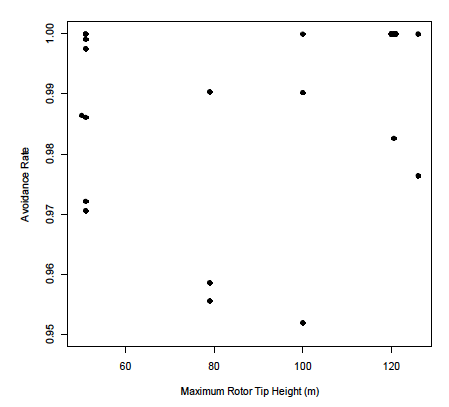
Figure 6.19 Relationship between maximum rotor tip height and the avoidance rate derived using option 1 of the Band model for all gulls.
6.4.4 Seasonality
Our analysis of the data from Zeebrugge present limited evidence that there may be a seasonal aspect to collision risk (see Section 5.1). These data suggest that avoidance rates may be higher in the autumn than in the breeding season. This may be related to two factors. Firstly the presence of younger, inexperienced birds which may have riskier flight behaviour ( e.g. Henderson et al. 1996). Secondly, given that several of our study sites were located on the edge of breeding colonies, it may be that during the breeding season birds arriving at colonies focus on locating their nests and are therefore less likely to see turbines, increasing the collision risk.
6.4.5 Applicability of avoidance rates between species
Avoidance rates are likely to be linked to a bird's ability to detect a turbine and perceive it as a potential threat in sufficient time to take action to avoid collision. Whilst we have able to derive a within-windfarm avoidance rate for gulls, we have been unable to come up with a suitable value for northern gannet due to lack of data. Therefore we consider other supporting evidence to evaluate whether for northern gannet total avoidance rates are likely to be higher or lower than those for gulls.
Total avoidance rates are likely to be a combination of the probability of a bird detecting a turbine and its ability to take last-second action to avoid collision. Ability to take last-second avoidance action is likely to be linked to a species manoeuvrability and a previous review used this as the basis for recommending avoidance rates for different species (Maclean et al. 2009). In general, expert opinion suggests that the flight manoeuvrability of northern gannets may be less than that of gulls (Garthe and Hüppop 2004, Furness et al. 2013), suggesting that they need more time to react to the presence of a turbine, and may therefore need to detect it earlier. Evidence from our review suggests that a high proportion of northern gannets avoid entering windfarms (Krijgsveld et al. 2011, Vanermen et al. 2013). In addition, observations undertaken within offshore windfarms suggest that very few northern gannets pass close enough to turbines to be at risk of collision (see section 5.1).
Birds are likely to be better able to detect obstacles, such as turbines, when they are looking straight ahead, as opposed to down, towards the sea-surface (Martin 2010). At sea, it may be reasonable to assume that birds will look downwards when actively foraging, and straight ahead when migrating or commuting between their breeding colonies and foraging areas. Northern gannet typically forage using area-restricted search ( ARS) behaviour (based on diving activity) resulting in a relatively small proportion of the total area covered being actively used when at sea (Hamer et al. 2009, Votier et al. 2013). These ARS zones are found solely on the outbound part of the foraging trip. In contrast, gulls are not likely to limit their foraging area to such restricted zones within foraging trips (Kubetzki and Garthe 2003, Schwemmer and Garthe 2005), and may therefore spend a greater proportion of their time at sea looking towards the sea-surface. The distance over which birds can see is strongly correlated with body size (Brooke et al. 1999). As a consequence, northern gannets are likely to be able to detect turbines at a greater distance than gulls. Recent evidence suggests that northern gannets may respond to the presence of fishing vessels over distances of up to 11 km (Bodey et al. 2014). These results suggest that, at least theoretically, northern gannets may be capable of responding to the presence of a windfarm over considerable distances.
Whilst insufficient data were available to derive within-windfarm avoidance rates for northern gannets, evidence of strong avoidance of windfarms, in contrast to gulls which appear to show no consistent response, suggests that total avoidance rates for northern gannets are unlikely to be lower than those for gulls.
6.4.6 Comparability of onshore and offshore avoidance rates
The difficulty of recording collisions in the offshore environment has meant that estimates of within-windfarm avoidance rely on data collected from terrestrial windfarms. However, birds may respond differently to onshore and offshore turbines. For example, migrating geese have been found to consistently avoid entering offshore windfarms, demonstrating macro-avoidance, (Plonckzkier & Simms 2012) but may habituate to the presence of onshore turbines (Madsen & Boertmann 2008).
Understanding how avoidance behaviour differs between onshore and offshore environments requires an understanding of how flight behaviour differs between the two. Modern GPS tracking technologies have made such comparisons easier, and it appears that whilst lesser black-backed gulls may spend a similar proportion of their time in flight in both environments (Kolios 2009), there is a tendency to fly lower when offshore (Corman & Garthe 2014, Ross-Smith et al. in prep.). As this would result in fewer flights at risk height in the offshore than onshore environment, this would be accompanied by decrease in both the proportion of birds at risk height (and therefore the predicted collision rate) and the actual collision rate of the same proportion. Consequently the avoidance rate would be unchanged between the onshore and offshore environments. However, there remain a number of other possible differences between onshore and offshore flight behaviour. Gulls are capable of adjusting their flight mode in response to airflow patterns which differ between onshore and offshore environments, in order to minimize their energy expenditure (Shamoun-Baranes & van Loon 2006). In the onshore environment they can take advantage of thermals by soaring and wind blowing up slopes or other major topographical features resulting in slope lift soaring. Whereas in the offshore environment a boundary layer can be created as the wind blows over the surface of the sea resulting in differential air wind speeds which some seabirds including gulls can exploit for dynamic soaring (see Alexander 2004). It is unclear how these adjustments between soaring and flapping flight may influence collision risk, though changes in manouverability and flight speed may be important. At present, there are significant gaps in our understanding of how flight behaviour may differ between onshore and offshore environments, though recent technological advances may start to fill these gaps. However, at present, the data describing within-windfarm avoidance rates collected from onshore sites remains our best available evidence.
Contact
There is a problem
Thanks for your feedback